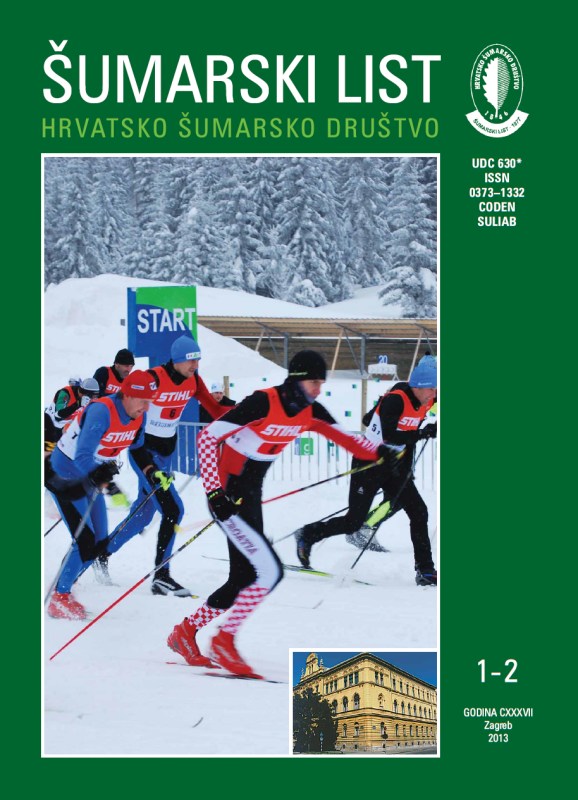
broj: 1-2/2013
pdf (7,9 MB) |
|
||||||||||||||
| RIJEČ UREDNIŠTVA | ||
| Uredništvo | ||
| 45TH EFNS ENDS SUCCESSFULLY pdf HR EN | 5 | |
| IZVORNI ZNANSTVENI ČLANCI | ||
| Dževada SOKOLOVIĆ, Dragutin PIČMAN, Ahmet LOJO, Safet GURDA, Muhamed BAJRIĆ, Haris KOLJIĆ | UDK 630*383+686 (001) | |
| DETERMINATION OF OPTIMAL SECONDARY FOREST ROAD NETWORK LAYOUT pdf HR EN | 7 | |
| Gregor BOŽIČ, Mladen IVANKOVIĆ, Lado KUTNAR | UDK 630*165+187 (Fagus sylvatica L.) (001) | |
| GENETIC STRUCTURE OF EUROPEAN BEECH (Fagus sylvatica L.) SEED STANDS FROM DIFFERENT FOREST SITES OF GORJANCI MOUNTAINS AS REVEALED BY ISOENZYMES pdf HR EN | 25 | |
| Savo Rončević, Siniša Andrašev, Petar Ivanišević, Branislav Kovačević, Bojana Klašnja | UDK 630*537+262 (001) | |
| BIOMASS PRODUCTION AND ENERGY POTENTIAL OF SOME EASTERN COTTONWOOD (Populus deltoides Bartr. ex Marsh.) CLONES IN RELATION TO PLANTING SPACING pdf HR EN | 33 | |
| Magda Sindičić, Tomislav Gomerčić, Primož Polanc, Miha Krofel, Vedran Slijepčević, Nina Gembarovski, Martina Đurčević, Đuro Huber | UDK 630*135+14 (Lynx lynx) (001) | |
| KINSHIP ANALYSIS OF DINARIC LYNX (Lynx lynx) POPULATION pdf HR EN | 43 | |
| Emanuel Kula, Alena Pešlová, Petr Martinek, Pavel Mazal | UDK 630*145.7 (001) | |
| THE DEVELOPMENT OF CATERPILLARS OF GYPSY MOTH (Lymantria dispar L.) FEEDING ON FOOD AFFECTED BY NITROGEN pdf HR EN | 51 | |
| Jovana PETROVIĆ, Nenad STAVRETOVIĆ, Srećko ĆURČIĆ, Ivana JELIĆ, Bojana MIJOVIĆ | UDK 630*411+442 (001) | |
| INVASIVE PLANT SPECIES AND GROUND BEETLES AND ANTS AS POTENTIAL OF THE BIOLOGICAL CONTROL: A CASE OF THE BOJČIN FOREST NATURE MONUMENT (VOJVODINA PROVINCE, SERBIA) pdf HR EN | 61 | |
| Summary The main aim of the conducted research was to determine the presence of invasive plant species in the protected natural area of the Bojčin Forest Nature Monument. Floristic and vegetation study of the Bojčin Forest was conducted through several vegetation periods (from March 2009 to November 2011). The presence of 185 plant species recorded in the area of the Bojčin Forest reflects its flora richness. Out of the total number of recorded species, 31 taxa are listed as invasive plant species (Table 1), which makes 16.76% of the total flora of the Bojčin Forest Nature Monument. Among them, there are nine woody plant species and 22 herbaceous plant species. Among the tree species, Amorpha fruticosa L. should be particularly emphasized. It forms a thick shrub formation by the Jarčina Canal with reed [Phragmites australis (Cav.) Trin. ex Steud.] (Fig. 1). Also significant is the presence of the species Symphyotrichum lanceolatum (Willd.) Nesom, forming an edge of width of 4 m between forest and meadow where the all other plant species were repressed (Fig. 2). The greatest number of determined invasive plant species belong to the family Asteraceae (eight species), then to the families Fabaceae and Rosaceae (three species each), Amaranthaceae and Oxalidaceae (two species each), whereas the other families had a single invasive species each. During the 2011 year, insect fauna in the area of the Bojčin Forest was studied, with special emphasis on economically important species. It was found that the Bojčin Forest is inhabited by a total of 93 insect species. Among them, very significant are ground beetles (family Carabidae), especially some of them acting as predators of many insect pests. Ground beetles were registered in the Bojčin Forest with total of nine species and three subspecies. Three ant species were registered in the researched area of the Bojčin Forest. Some ground beetles and ants have been proved as a good group to reduce numbers of certain weed species, as they use seeds of these pests as the food. These insect species may be used in biological control of some harmful invasive plants. Research results should provide a basis for development of strategies for monitoring the state of unwanted species and planning measures of their reduction in order to protect the autochthonous flora. Only careful and responsible management of the natural area would maintain the abundance of these species at the current level. Key words: Bojčin Forest; invasive species; environment protection; nature protection; biological control | ||


